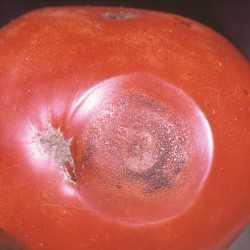Pest Of The Month: Anthracnose of Tomato

Identification
Tomato growers in West Central Florida are reporting a higher than usual incidence of anthracnose this fall.
Foliar symptoms are usually mild and may be overlooked. They consist of small, tannish lesions with a brown margin and some chlorosis around the lesion. The chlorosis may expand as the lesions coalesce. Small raised fruiting bodies may be observed within the lesion with a hand lens. These exude spores in the presence of water. The spores are easily dispersed throughout the canopy with rain.
The fungus can infect both green and red fruit and is able to penetrate the cuticle of uninjured fruit. When green fruit is infected, it is not apparent until it begins to ripen. On ripe fruit, lesions become visible within a few days of infection.
Lesions consist of small water-soaked areas that develop under the skin of fruit. The lesions collapse as they develop and become sunken and dark. Numerous dark specks, the fruiting bodies of the fungus known as acervuli, develop in concentric circles in the center of the lesion and make the lesion dark brown to black in color. In moist warm weather, these black bodies ooze gelatinous pink spore masses. In warm weather, the fungus — along with secondary pathogens, including soft rot bacteria — enter the lesions and spread, causing a soft rot, which renders the fruit worthless.
Survival And Spread
The fungus survives between crops on infested plant debris in the soil. Early in the growing season, spores from the soil splash on lower leaves of the tomato plant. Few symptoms develop on infected leaves, but the spores produced on foliage can be carried by splashing rain to developing green fruit.
Colletotrichum spp. are considered weak pathogens of tomato and pepper, but can be quite severe when with heavy rains followed by periods of prolonged leaf wetness. Growth of C. coccodes is most rapid at 80°F, although the fungus can cause infections over a wide range of temperatures. Wet weather promotes disease development, and splashing water aids in the spread of the disease.
Management Methods
Fungicides are most effective when used in combination with cultural control strategies. Cultural controls include 2- to 3-year rotations between susceptible hosts as well as elimination of weeds, volunteers, and culls that serve as survival medium for the anthracnose pathogen by deep burial. Staking and irrigation practices that promote rapid leaf drying and reduce extended periods of leaf wetness also will help reduce infections.
If conditions favor development of anthracnose, a preventative spray program may be required for control. Applications to tomatoes should begin when the first fruit are the size of a quarter.










